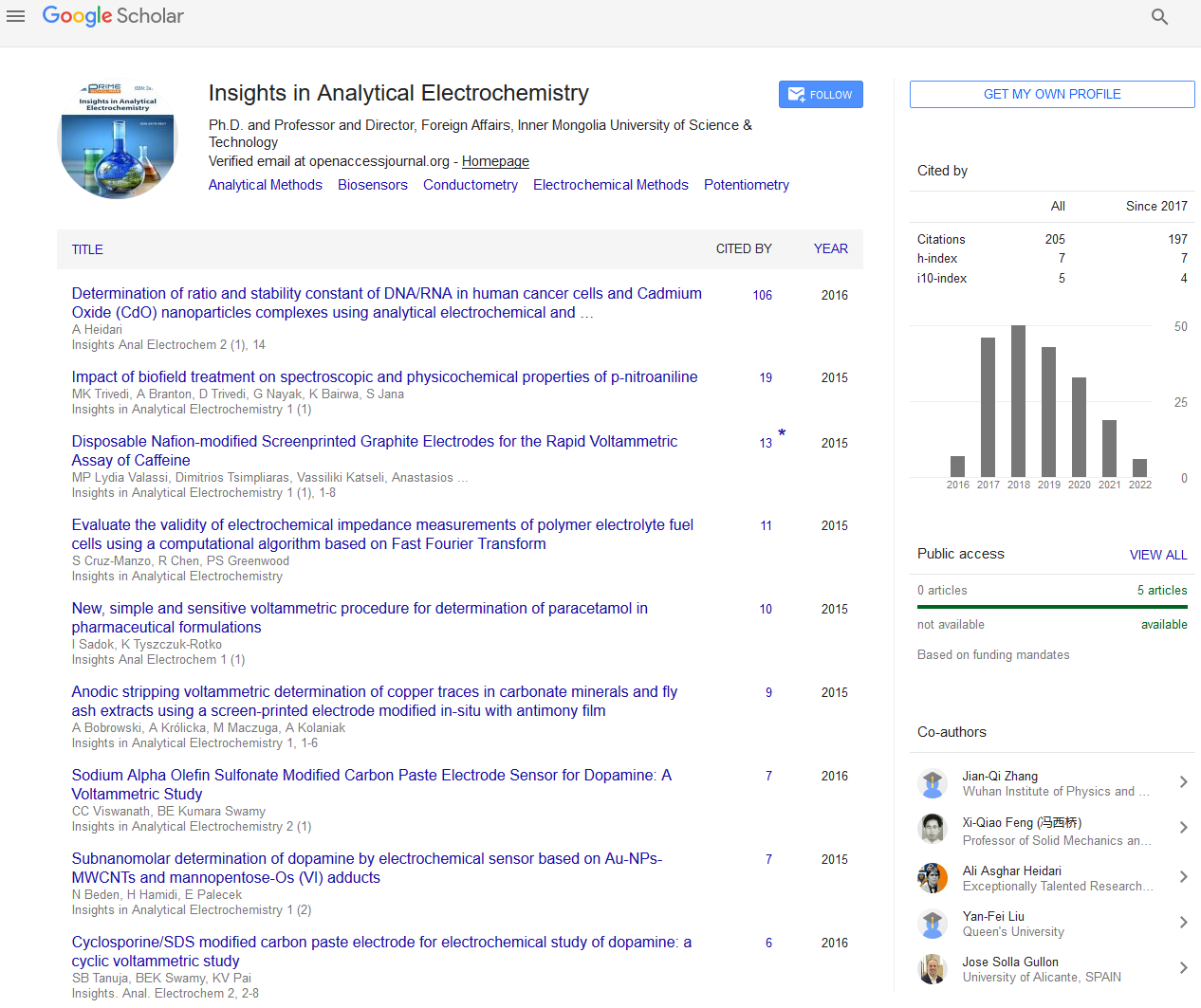Perspective - (2023) Volume 9, Issue 4
Unveiling the Mysteries of Electrogravimetry: Bridging the Gap Between Electricity and Gravity
Olivia Reynolds*
Department of Biochemistry and Molecular Biology, Institute of Medical Sciences, United Kingdom
*Correspondence:
Olivia Reynolds,
Department of Biochemistry and Molecular Biology, Institute of Medical Sciences,
United Kingdom,
Email:
Received: 29-Nov-2023, Manuscript No. ipaei-24-18843;
Editor assigned: 01-Dec-2023, Pre QC No. ipaei-24-18843 (PQ);
Reviewed: 15-Dec-2023, QC No. ipaei-24-18843;
Revised: 20-Dec-2023, Manuscript No. ipaei-24-18843 (R);
Published:
27-Dec-2023, DOI: 10.21767/2470-9867-9.4.32
Introduction
Electrogravimetry, a fascinating scientific technique that
intertwines the realms of electricity and gravity, has been
a subject of intrigue and exploration for researchers seeking
to unravel its potential applications and unlock the secrets
it holds. This analytical method, rooted in the principles of
electrochemistry, provides a unique avenue to measure the
mass of a substance through the deposition of a metal on
an electrode, offering valuable insights into diverse fields
such as metallurgy, environmental science, and materials
engineering. At its core, electrogravimetry relies on the
conversion of electrical energy into gravitational force to with
the introduction of a metal cation-containing solution, often in
the form of a salt, into an electrochemical cell. A direct current
(DC) is then applied, inducing the reduction of metal cations at
the cathode, resulting in the deposition of the metal in its solid
form. The mass of the deposited metal is directly proportional
to the amount of electricity passed through the cell, providing
a quantitative measure of the original metal cations present in
the solution.
Description
One of the notable advantages of electrogravimetry lies in its
high precision and accuracy, making it an indispensable tool in
analytical chemistry. The method allows for the determination
of trace amounts of metals with exceptional sensitivity, crucial
in various industries where precise quantification is paramount.
Applications span from the analysis of heavy metals in
environmental samples to quality control in metallurgical
processes, where even minute deviations can have significant
implications. Environmental monitoring benefits significantly
from the capabilities of electrogravimetry. With concerns over
pollution and its impact on ecosystems and human health, the
ability to detect and quantify trace metals in air, water, and
soil samples becomes paramount. Electrogravimetric analysis
empowers researchers to meticulously assess the levels of
pollutants, aiding in the formulation of effective mitigation
strategies and regulatory measures. Metallurgy, the science
and technology of metals, also reaps rewards from the insights
provided by electrogravimetry. The precise determination
of metal concentrations in ores and alloys ensures the
production of high-quality materials with specific properties.
This is particularly vital in industries such as aerospace and
electronics, where the composition of metals can directly
influence the performance and reliability of end products. The
application of electrogravimetry extends beyond quantitative
analysis; it serves as a bridge between disciplines, fostering
interdisciplinary research and innovation. The convergence
of electricity and gravity in this method sparks curiosity and
collaboration among scientists from diverse backgrounds.
As researchers delve deeper into the intricacies of
electrogravimetry, new possibilities and applications continue
to emerge, pushing the boundaries of our understanding
and technological capabilities. While electrogravimetry has
proven its mettle in various scientific domains, challenges and
opportunities for refinement persist.
Conclusion
In conclusion, electrogravimetry stands as a testament to
the marvels of scientific exploration, seamlessly blending the
fundamental forces of electricity and gravity to provide precise
and invaluable analytical insights. Its applications, ranging
from environmental monitoring to materials engineering,
underscore its versatility and significance in advancing our
understanding of the physical world. As researchers continue
to unravel the mysteries of electrogravimetry, the potential for
groundbreaking discoveries and transformative applications
remains boundless, promising a future where the synergy of
forces propels us into new realms of scientific achievement.
Citation: Reynolds O (2023) Unveiling the Mysteries of Electrogravimetry: Bridging the Gap between Electricity and Gravity. Insights Anal Electrochem. 9:32.
Copyright: © 2023 Reynolds O. This is an open-access article distributed under the terms of the Creative Commons Attribution License, which permits unrestricted use, distribution, and reproduction in any medium, provided the original author and source are credited.

